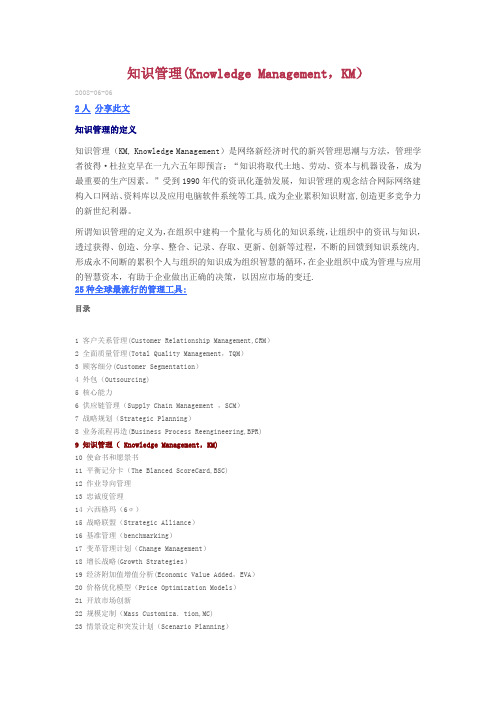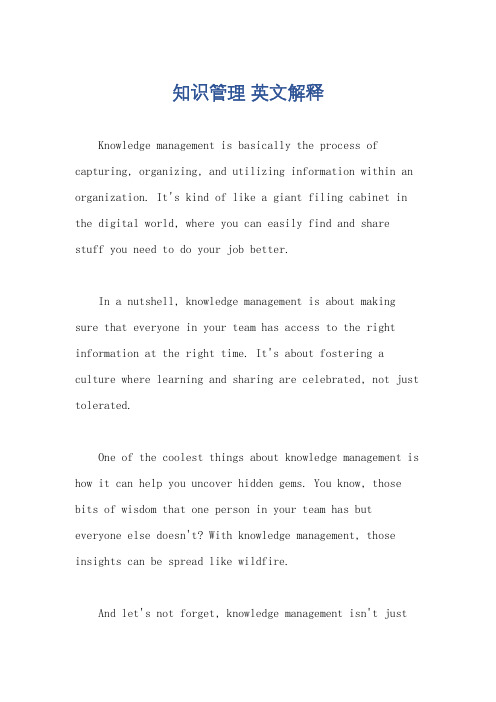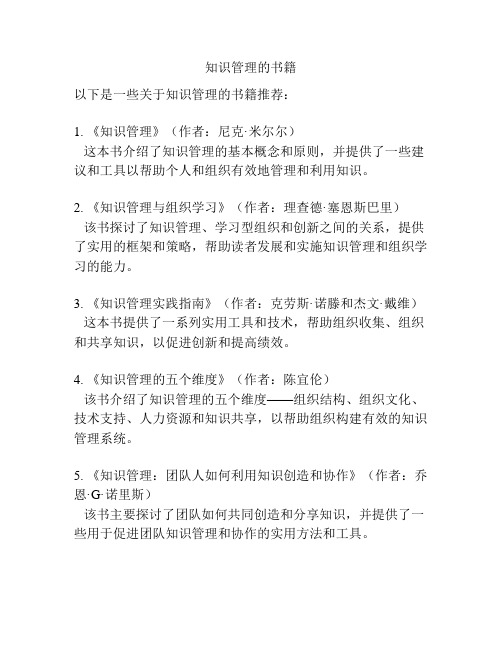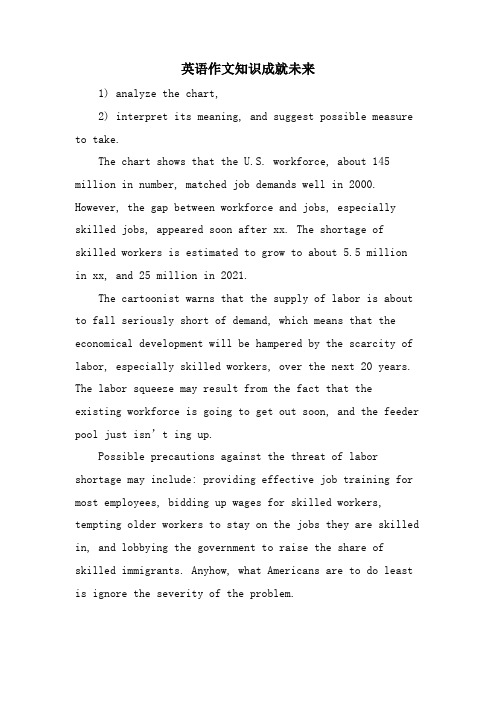知识管理的未来(英文版)
知识管理(Knowledge-Management-KM)

知识管理(Knowledge Management,KM)2008-06-062人分享此文知识管理的定义知识管理(KM, Knowledge Management)是网络新经济时代的新兴管理思潮与方法,管理学者彼得·杜拉克早在一九六五年即预言:“知识将取代土地、劳动、资本与机器设备,成为最重要的生产因素。
”受到1990年代的资讯化蓬勃发展,知识管理的观念结合网际网络建构入口网站、资料库以及应用电脑软件系统等工具,成为企业累积知识财富,创造更多竞争力的新世纪利器。
所谓知识管理的定义为,在组织中建构一个量化与质化的知识系统,让组织中的资讯与知识,透过获得、创造、分享、整合、记录、存取、更新、创新等过程,不断的回馈到知识系统内,形成永不间断的累积个人与组织的知识成为组织智慧的循环,在企业组织中成为管理与应用的智慧资本,有助于企业做出正确的决策,以因应市场的变迁.25种全球最流行的管理工具:目录1 客户关系管理(Customer Relationship Management,CRM)2 全面质量管理(Total Quality Management,TQM)3 顾客细分(Customer Segmentation)4 外包(Outsourcing)5 核心能力6 供应链管理(Supply Chain Management ,SCM)7 战略规划(Strategic Planning)8 业务流程再造(Business Process Reengineering,BPR)9 知识管理( Knowledge Management,KM)10 使命书和愿景书11 平衡记分卡(The Blanced ScoreCard,BSC)12 作业导向管理13 忠诚度管理14 六西格玛(6σ)15 战略联盟(Strategic Alliance)16 基准管理(benchmarking)17 变革管理计划(Change Management)18 增长战略(Growth Strategies)19 经济附加值增值分析(Economic Value Added,EVA)20 价格优化模型(Price Optimization Models)21 开放市场创新22 规模定制(Mass Customiza.tion,MC)23 情景设定和突发计划(Scenario Planning)24 海外经营25 射频识别(Radio Frequency Identification,RFID)知识管理的重要性21世纪企业的成功越来越依赖于企业所拥有知识的质量,利用企业所拥有的知识为企业创造竞争优势和持续竞争优势对企业来说始终是一个挑战。
《组织行为学》课程教学大纲

课程名称组织行为学(Science of organizationalbehaviorsience)(中英文)课程代码113102101321课程属性专业知识课时/学分2课程性质选修实践学时责任教师课外学时课程属性:公共基础/通识教育/学科基础/专业知识/工作技能,课程性质:必修、选修一、课程介绍1.课程描述:该课程为公共管理学科本科专业学生专业知识选修课程。
该课程包括绪论、个体行为、群体与团队行为、组织行为、个人与组织的关系五部分内容。
(This course is an elective course of public management.The course consists of five parts:introduction,individual behavior,group team behavior,organizational behavior,and the relationship betwneen individual and organimation.)3.课程与其他课程的关系:组织行为学是一门以管理学、行政管理学、社会心理学为理论基础支撑的新兴学科。
因此,学习组织行为学课程之前,学生应该先研修管理学、行政管理学、社会心理学,这样才能更好地理解组织行为学的学科体系和内容,修完之后再研修公共部门人力资源管理课程,就能更好地掌握如何激励组织中的员工更好的工作和学习,取得最优绩效。
二、课程目标引导学生将对西方组织行为学理论与中国情境下的组织管理实践相结合,更多地引用中国学者的研究成果和中国组织的实践成果作为课堂讲授案例,以期以丰富、完善或替代西方组织行为学的教研目标,推动组织行为学的中国化、本土化。
三、学习要求-1-1、课程学习的同时,研读管理大师德鲁克的《管理的实践》和《卓有成效的管理者》。
2、课堂思考和讨论“组织行为学”这门课在管理学科体系中的地位和作用;3、分析讨论“富士康跳楼事件”,分析悲剧的原因以及对中国管理的启示。
管理学知识(全英文版的)

• Explain how the contingency approach differs from the early theories of management.
• Discuss how the contingency approach is appropriate for studying management.
❖ The theory of scientific management
– Using scientific methods to define the “one best way” for a job to be done:
• Putting the right person on the job with the correct tools and equipment.将正确的人员安排在适当的工作上,采用正确的工 具和设备
Development of Major Management Theories
Copyright © 2005 Prentice Hall, Inc. All rights reserved.
Exhibit 2.1
2–9
Major Approaches to Management
• Scientific Management 科学管理 • General Administrative Theory 行政管理 • Quantitative Management 质量管理 • Organizational Behavior 组织行为 • Systems Approach 系统理论 • Contingency Approach 权变理论
Copyright © 2005 Prentice Hall, Inc. All rights reserved.
英语作文专业未来发展趋势

英语作文专业未来发展趋势The Future Development Trends of English Language Education.The field of English language education has undergone significant transformations in recent years, driven by advancements in technology, changing global dynamics, and evolving learner needs. As we look ahead, several distinct trends emerge that are likely to shape the future of this vital discipline.1. Technological Integration.The integration of technology into the classroom is one of the most significant trends in English language education. The advent of digital platforms, mobile applications, and online resources has made it easier for learners to access content and practice their language skills. Virtual reality, augmented reality, and artificial intelligence are also starting to find their way intolanguage classrooms, offering immersive and personalized learning experiences. These technological advancements have the potential to revolutionize teaching methods and make language learning more engaging and effective.2. Globalization and Multilingualism.The increasing globalization of education and business has led to a growing demand for proficiency in English and other languages. Multilingualism is becoming increasingly valued in today's interconnected world, and English language education is often the first step in developing cross-cultural communication skills. As a result, there is a growing focus on teaching English as an international language, with a focus on cultural sensitivity and cross-cultural communication.3. Emphasis on Communicative Competence.The traditional focus on grammar and vocabulary is gradually being replaced by a greater emphasis on communicative competence. This shift reflects a recognitionthat language learning is not just about acquiring knowledge but also about developing the ability to use language effectively in real-world situations. As a result, there is a growing emphasis on speaking and listening skills, as well as on developing learners' confidence in using English in a variety of contexts.4. Personalized Learning.The rise of personalized learning is another key trend in English language education. This approach recognizesthat learners have different needs, preferences, and learning styles, and it aims to tailor teaching methods and materials to meet these individual differences. The use of data analytics and learning management systems can help teachers track learners' progress and identify areas where additional support is needed, leading to more effective and efficient teaching.5. Collaborative Learning.Collaborative learning is becoming increasinglyimportant in English language education. This approach encourages learners to work together in small groups to solve problems, complete tasks, and share knowledge. It fosters a sense of community and cooperation among learners, helps them develop their social skills, and prepares themfor the collaborative work environments they will encounter in the future.6. The Role of Teachers.Despite the increasing role of technology in English language education, the role of teachers remains crucial. Teachers are responsible for guiding learners, facilitating discussions, providing feedback, and creating an inclusive and supportive learning environment. As the field evolves, teachers will need to adapt their teaching methods to incorporate new technologies and teaching approaches while maintaining a focus on the human element of language learning.In conclusion, the future of English language education looks bright, with numerous opportunities for innovationand growth. The integration of technology, the emphasis on communicative competence and personalized learning, therise of collaborative learning, and the critical role of teachers are all shaping the way we approach language education. By staying abreast of these trends andcontinuously adapting and improving our teaching methods, we can ensure that English language education remains relevant, effective, and engaging for learners of all ages and backgrounds.。
知识管理的现状和发展方向

知识管理的现状和发展方向导言:当今社会,知识已经成为最为宝贵和重要的资产之一。
随着信息技术的发展、企业竞争的加剧,知识管理在实践中显得愈发重要。
本文将探讨知识管理的现状和发展方向,旨在帮助读者了解知识管理的实践意义与未来趋势。
一.知识管理的现状1.1 知识经济时代的到来随着知识经济时代的到来,人们逐渐认识到知识的价值和重要性。
知识不再仅仅是教育领域的专有领域,它已经渗透到各个行业和领域,影响企业的竞争力和发展潜力。
1.2 知识管理的定义知识管理是一种组织和配置知识资源的方法和过程,旨在提高组织的效益和创新力。
它包括知识的获取、创建、储存、共享和应用等环节,以实现知识的最大化利用和组织绩效的提升。
在知识管理的实践中,企业通常采取多种手段和工具,如知识库、协同平台、培训和分享会议等,以便更好地利用和共享知识。
这些实践旨在通过加强知识的流动和交流,促进团队间的合作和创新。
1.4 知识管理的挑战尽管知识管理在实践中具有重要意义,但也面临着诸多挑战。
企业需要克服的问题包括信息过载、知识孤岛、人员变动等。
在信息爆炸的时代,企业如何找到有效的知识,并将其转化为创新和竞争力,是知识管理面临的重要挑战。
二.知识管理的发展方向2.1 技术驱动的知识管理随着信息技术的不断进步,技术驱动的知识管理将成为未来的发展方向。
人工智能、大数据、云计算等新技术的应用,将为知识管理提供更加智能化、高效化的解决方案。
企业可以利用这些技术挖掘、分类和传播知识,实现知识的更好利用和管理。
社交化的知识管理是一种基于社交网络的知识共享和协作方式。
通过构建企业内部社交平台,员工可以通过分享和讨论,找到更多有价值的知识资源和解决方案。
这种知识管理方式可以促进员工之间的互动和创新,提高企业的绩效和竞争力。
2.3 跨界合作的知识管理知识管理不仅仅局限于企业内部,也可以跨越组织和行业进行合作。
通过与供应商、合作伙伴和行业专家的合作,企业可以获得更广泛和深入的知识资源,以应对竞争压力和市场变化。
知识管理相关书籍

知识管理相关书籍知识管理是一种被广泛应用的商业策略和管理工具。
在如今竞争性十分激烈的商业领域,各个公司都希望能够争取在市场上获得竞争优势,从而创造更好的商业成果。
知识管理是一个非常有力的实现这一目标的途径,可以提高企业的工作效率和协作能力,同时也可以加强员工之间的联系和信息共享。
为帮助企业经理和从业人员更好地理解知识管理的概念和实践方法,许多优秀的知识管理相关书籍已经问世。
以下是我个人推荐的几本。
第一本是David J. Skyrme所著的《企业知识组织实践》,这是一本第三版的书,由 Wiley 和 Sons 出版。
这本书主要探讨了企业如何有效地管理和组织其知识和信息资源。
作者从理论和实践两个角度出发,介绍了如何创建和运营知识管理系统,如何识别和分类知识资产,并介绍了一些成功案例和最佳实践。
第二本书是Thomas Davenport和Larry Prusak所著的《信息情报:在复杂的商业世界中生存的关键》。
这本书不只局限于讲述知识管理相关的知识和信息如何被处理,还比较注重知识管理实践的挑战和应对方法。
作者从管理和战略两方面出发,介绍了如何充分利用信息资源,实现企业目标并在竞争市场中生存。
第三本书是Peter F. Drucker所著的《经理人的效能》。
虽然这本书并非专门讨论知识管理,但作者所提供的管理的理论和指导性意见对于任何一位知识管理者来说都是至关重要的。
Peter F. Drucker是管理领域的先驱,凭借其独特的洞察和分析能力,为管理理论和实践做出了重大贡献。
《经理人的效能》则是其最著名的作品之一。
第四本书则是由Gary Klein所著的《洞察力:如何在知识管理中做出正确的决策》。
在知识管理的实践中,做出正确的决策通常是一项至关重要的任务。
《洞察力》这本书的重点则在于,如何从大量的信息中寻找到有关情况的本质,并在复杂的环境中做出明智的决策。
以上四本书籍均是涵盖了不同方面的知识管理实践内容,对于想要更好地掌握知识管理方法和实践的人而言都是非常有价值的参考。
项目管理未来:通往2045年之路 -《Future of Project Management(项目管理的未来)》研究报告解读

项目管理未来:通往2045年之路项目管理的未来发展趋势是什么?英国UCL大学、APM(英国项目管理协会)和全球著名工程咨询公司奥雅纳(ARUP)对此开展了联合研究,发布了《Future of Project Management(项目管理的未来)》研究报告。
图 1 报告封面图报告前言部分展现了2045年之前项目管理的发展历程。
项目管理从金字塔、长城和甘特图开始,经过了20世纪60至70年代航空、建筑和国防领域的现代项目管理发展,再到90年代后逐步标准化,愈发注重程序和方法,项目管理客户中心化和专业化趋势开始凸显。
图 2 项目管理发展历程(2045年前)几个重要节点包括(英国视角):1990年前后:奥雅纳发起了项目管理业务;互联网引入1995年前后:CCTA发布了Priince2标准2000年前后:PMBOK发布成为标准;“敏捷项目管理”提出2005年前后:希思罗机场开始运行2010年前后:项目管理作为五大需求技能之一;伦敦奥运会举办2015年前后:移动设备和链接数量超过地球上总人口数量;APM成为英国皇家特许项目职业体系2020年前后:资源危机;项目数据的区块链涌现2025年前后:社会责任成为PMBOK的一章;每秒1TB的光纤开始安装2030年前后:世界100强公司在高层管理层都设有项目管理专业人士2035年前后:项目管理成为英国国家课程的一部分;神经技术(Neuro-technologies)普及2040年前后:智能算法超过专家判断2045年前后:虚拟心灵感应主宰个人沟通报告主体内容分为三部分展开:首先基于当下情境分析项目管理未来的大趋势;然后结合案例分析,从项目经理视角展望未来的项目交付;最后提出倡议,为项目管理未来的研究方向和行动方案勾勒出大致的蓝图。
以下将对各部分内容进行简要介绍。
驱动力和趋势驱动力和趋势(Trends and Drivers)指的是存在于社会、技术、经济、环境、政治领域的各种驱动因子,它们足以塑造未来世界的方方面面,为项目管理带来机会的同时,也带来巨大风险。
知识管理(KM, Knowledge Management)

知识管理(KM, Knowledge Management)
知识管理(KM, Knowledge Management)是网络新经济时代的新兴管理思潮与方法,管理学者彼得·杜拉克早在一九六五年即预言:「知识将取代土地、劳动、资本与机器设备,成为最重要的生产因素。
」受到1990年代的信息化(资讯化)蓬勃发展,知识管理的观念结合网际网络建构入口网站、数据库以及应用电脑软件系统等工具,成为组织累积知识财富,创造更多竞争力的新世紀利器。
所谓知识管理的定义为,在组织中建构一个人文与技术兼备的知识系统,让组织中的信息与知识,透过获得、创造、分享、整合、记录、存取、更新等过程,达到知识不断创新的最终目的,并回馈到知识系。
管理层英文缩写及职责

首席品牌官【CBO】chief brand officer首席文化官【CCO】Chief Cultural Officer开发总监【CDO】chief Development officer首席执行官【CEO】Chief Executive officer首席财务官【CFO】Chief finance officer人事总监【CHO】Chief Human resource officer 首席信息官【CIO】chief information officer首席知识官【CKO】chief knowledge officer首席市场官【CMO】chief Marketing officer首席谈判官【CNO】chief Negotiation officer公关总监【CPO】chief Public relation officer质量总监【CQO】chief Quality officer销售总监【CSO】chief Sales officer首席技术官【CTO】chief Technology officer评估总监【CVO】chief Valuation officer一、CEO首席执行官(Chief Executive Officer,缩写CEO)是在一个企业中负责日常事务的最高行政官员,又称作行政总裁、总经理或最高执行长。
他向公司的董事会负责,而且往往就是董事会的成员之一。
在公司或组织内部拥有最终的执行权力。
在比较小的企业中首席执行官可能同时又是董事会主席和公司的总裁,但在大企业中这些职务往往是由不同的人担任的,避免个人在企业中扮演过大的角色、拥有过多的权力,同时也可以避免公司本身与公司的所有人(即股东)之间发生利益冲突。
企业首席执行官制度的出现是对传统公司治理结构的新挑战近年来,我国一些企业纷纷实行首席执行官制度,出现了我国历史上首批企业首席执行官(以下简称CEO)。
为此,我们首先要回答的是:什么是CEO?中国为何要有CEO?企业首席执行官的涵义,按照我的理解,可以简单地理解为企业领导人与职业经理人两种身份的合一。
哈佛商业评论知识管理精译

哈佛商业评论知识管理精译知识管理(Knowledge Management,简称KM)是一种通过集中和整合知识资源,分析、开发和应用知识,以提高组织绩效和创造竞争优势的管理方法。
在当今竞争激烈的商业环境中,知识管理被认为是企业成功的关键因素之一。
哈佛商业评论中关于知识管理的文章提供了许多有价值的观点和策略,本文将对其中几篇精彩的内容进行精译和概括。
一、知识共享与联系(Knowledge Sharing and Connection)知识共享是知识管理的核心。
毕竟,知识如果只停留在个人的脑海中,并不会带来真正的价值和影响。
借鉴开放创新的概念,哈佛商业评论指出,企业应该鼓励和建立一种文化,使得员工能够自由地共享他们的知识和经验。
同时,通过搭建交流平台和社交网络,促进员工之间的联系和互动也是至关重要的。
二、知识获取与提炼(Knowledge Acquisition and Refinement)在知识管理中,获取和提炼知识是一个循环的过程。
哈佛商业评论提出了一种有效的方法,即引入外部知识。
通过与外部合作伙伴、学术界以及行业专家进行合作,企业可以更好地获取前沿的知识和技术。
此外,通过对内部数据和信息的分析和整合,提炼出有价值的知识和经验也是知识管理的核心任务之一。
三、知识传承与创新(Knowledge Transfer and Innovation)知识传承是保证知识延续的重要环节。
哈佛商业评论指出,知识传承不仅仅是将知识从一代人传递给下一代人,更应该是一种跨世代的、持续的过程。
为此,企业需要建立起有效的知识分享机制和培训体系,以确保知识能够得以传承和应用。
与此同时,知识管理也需要与创新相结合。
哈佛商业评论强调,知识管理不应仅仅局限于存储和应用已有的知识,更应该鼓励创新和新知识的产生。
通过激励员工的创造力和提供创新的工作环境,企业能够不断地创造出新的价值和竞争优势。
四、培养知识管理文化(Cultivating a Knowledge Management Culture)要建立和推行知识管理,企业需要培养一种知识管理文化。
知识管理 英文解释

知识管理英文解释Knowledge management is basically the process of capturing, organizing, and utilizing information within an organization. It's kind of like a giant filing cabinet in the digital world, where you can easily find and sharestuff you need to do your job better.In a nutshell, knowledge management is about making sure that everyone in your team has access to the right information at the right time. It's about fostering a culture where learning and sharing are celebrated, not just tolerated.One of the coolest things about knowledge management is how it can help you uncover hidden gems. You know, those bits of wisdom that one person in your team has but everyone else doesn't? With knowledge management, those insights can be spread like wildfire.And let's not forget, knowledge management isn't justabout documents and data. It's also about the relationships, experiences, and best practices that make your team tick.It's about capturing those "ah-ha" moments and turning them into actionable insights.So, in a way, knowledge management is like a magic wand that transforms your organization's collective intelligence into something tangible and useful. It's the glue thatbinds your team together, making sure everyone's on the same page and moving forward together.。
业务管理及管理知识分析(英文版)

业务管理及管理知识分析(英文版)IntroductionIn today's rapidly evolving business environment, effective management is the key to success. Business management involves the coordination and control of various resources to achieve the organizational goals. This article aims to analyze the concept of business management and explore the essential knowledge and skills required for effective management.Concept of Business ManagementBusiness management can be defined as the process of planning, organizing, directing, and controlling the activities of an organization to achieve predetermined objectives. It involves decision-making, resource allocation, leadership, and monitoring to ensure the efficient and effective operation of the business.The main functions of business management can be categorized into four areas: planning, organizing, leading, and controlling. Planning involves setting goals and objectives, identifying resources, and developing strategies to achieve them. Organizing entails arranging resources and tasks to accomplish the objectives. Leading involves motivating and guiding individuals to work towards the organizational goals. Controlling involves monitoring and evaluating performance to ensure adherence to the plans and making necessary adjustments if required.Essential Knowledge and Skills for Effective Management1. Strategic Thinking: Strategic thinking is the ability to see the big picture and formulate long-term plans and strategies. A competent manager should have the foresight to anticipate changes in the business environment and develop proactive strategies to capitalize on opportunities and mitigate risks.2. Financial Management: Financial management knowledge is crucial for effective business management. Managers should be able to read and interpret financial statements, understand budgeting and cost control, and make informed decisions based on financial analysis.3. Leadership and People Management: The ability to lead and inspire a team is vital for successful management. Managers should possess effective communication skills, the ability to delegate tasks, motivate employees, and resolve conflicts. Building a positive work culture and creating a motivated workforce are critical for achieving organizational objectives.4. Project Management: Effective project management skills are necessary for managing complex tasks and achieving specific outcomes within a defined timeframe. Managersshould be proficient in planning, organizing, and coordinating resources to complete projects successfully.5. Marketing Management: Understanding market dynamics and consumer behavior is crucial for effective business management. Managers should have knowledge of marketing strategies, market research, competitive analysis, and product positioning to develop effective marketing plans and gain a competitive advantage.6. Change Management: In today's dynamic business landscape, managers must be adept at managing change. This includes identifying the need for change, communicating the change effectively, and leading the organization through the transition. Managers should possess strong change management skills to ensure a smooth and successful implementation of change initiatives.ConclusionEffective business management is a multifaceted discipline that requires a diverse range of knowledge and skills. Strategic thinking, financial management, leadership, project management, marketing management, and change management are some of the essential knowledge areas for successful management. By developing these skills and acquiring the necessary knowledge, managers can enhance their effectiveness and contribute to the overall success of the organization.继续写相关内容,1500字经营管理的关键能力1. 战略思维:战略思维是指能够看到全局并制定长期计划和策略的能力。
knowledge management research practice

knowledge management research practice
知识管理是指通过有效地利用和共享知识资源来提高组织绩效和竞争力的一种管理方式。
目前,知识管理已成为了企业和组织的一个重要部分。
在这种情况下,知识管理研究实践也得到了不断的改进和推广。
本文将通过以下步骤进行讲述。
第一步,明确知识管理的定义和目标。
知识管理是为了有效地获取、整理、传递和应用企业和组织内部的知识资源,提高组织的绩效和竞争力。
这需要进行有效的知识管理,将知识变成产品、服务和价值。
第二步,阐述知识管理的重要性。
知识是企业的重要资源,它的获取和传递对企业的发展至关重要。
知识管理可以有效地提高组织的创造力、创新能力和竞争力,在企业的长期发展中起到重要的作用。
第三步,讨论知识管理研究的实践和方法。
知识管理研究的实践和方法,包括知识诊断、知识分析、知识共享和知识保护。
这些方法可以帮助企业和组织有效地管理知识,提高组织的绩效和竞争力。
第四步,探讨知识管理研究的未来发展趋势。
随着科技的发展和信息的快速增长,知识管理将会与人工智能、大数据、区块链等技术相融合,成为更多企业和组织的重要领域。
未来的研究方向将涉及更多的技术进步和知识管理新理论的发展。
总之,知识管理是企业和组织必不可少的一部分,知识管理研究实践也将会不断改进和推广。
想要在企业中有效地管理知识,必须结合实际应用,探索新的方法和理论,从而实现企业的创新和发展。
知识管理的书籍

知识管理的书籍
以下是一些关于知识管理的书籍推荐:
1. 《知识管理》(作者:尼克·米尔尔)
这本书介绍了知识管理的基本概念和原则,并提供了一些建议和工具以帮助个人和组织有效地管理和利用知识。
2. 《知识管理与组织学习》(作者:理查德·塞恩斯巴里)
该书探讨了知识管理、学习型组织和创新之间的关系,提供了实用的框架和策略,帮助读者发展和实施知识管理和组织学习的能力。
3. 《知识管理实践指南》(作者:克劳斯·诺滕和杰文·戴维)这本书提供了一系列实用工具和技术,帮助组织收集、组织和共享知识,以促进创新和提高绩效。
4. 《知识管理的五个维度》(作者:陈宜伦)
该书介绍了知识管理的五个维度——组织结构、组织文化、技术支持、人力资源和知识共享,以帮助组织构建有效的知识管理系统。
5. 《知识管理:团队人如何利用知识创造和协作》(作者:乔恩·G·诺里斯)
该书主要探讨了团队如何共同创造和分享知识,并提供了一些用于促进团队知识管理和协作的实用方法和工具。
这些书籍从不同角度介绍了知识管理的概念、原理、实践和工具,可以帮助读者更好地理解和应用知识管理的思想和方法。
英语作文知识成就未来

英语作文知识成就未来1) analyze the chart,2) interpret its meaning, and suggest possible measure to take.The chart shows that the U.S. workforce, about 145 million in number, matched job demands well in 2000. However, the gap between workforce and jobs, especially skilled jobs, appeared soon after xx. The shortage of skilled workers is estimated to grow to about 5.5 million in xx, and 25 million in 2021.The cartoonist warns that the supply of labor is about to fall seriously short of demand, which means that the economical development will be hampered by the scarcity of labor, especially skilled workers, over the next 20 years. The labor squeeze may result from the fact that theexisting workforce is going to get out soon, and the feeder pool just isn’t ing up.Possible precautions against the threat of labor shortage may include: providing effective job training for most employees, bidding up wages for skilled workers, tempting older workers to stay on the jobs they are skilled in, and lobbying the government to raise the share of skilled immigrants. Anyhow, what Americans are to do least is ignore the severity of the problem.。
创新探索改变未来融入科学知识英语作文

创新探索改变未来融入科学知识英语作文Innovation and discovery hold the key to unlocking a future filled with endless possibilities. As we delve into the realm of science, we uncover a wealth of knowledge that serves as a catalyst for transformative ideas. The fusion of scientific principles with a spirit of relentless curiosity empowers us to push the boundaries of human ingenuity, leaving an indelible mark on the tapestry of human history.Scientific knowledge provides a solid foundation upon which innovation can soar. It illuminates the fundamental laws of nature, allowing us to comprehend the intricate workings of the universe. Armed with this understanding, we can manipulate and harness natural forces to create novel solutions to complex problems. From the unassuming light bulb to the awe-inspiring spacecraft that venture beyond our planet, scientific breakthroughs have shaped our world in countless ways.The invention of the transistor, a tiny electronic component that regulates the flow of electricity,epitomizes the transformative power of scientific knowledge. Its discovery revolutionized the field of electronics, paving the way for the development of computers, smartphones, and other indispensable technologies that permeate modern life. Similarly, the unraveling of the human genome has opened up unprecedented avenues formedical research, offering hope for the diagnosis and treatment of previously untreatable diseases.Beyond its practical applications, scientific knowledge also fosters a mindset conducive to innovation. By embracing the scientific method, we cultivate a culture of critical thinking, experimentation, and evidence-based reasoning. This approach encourages us to question thestatus quo, challenge assumptions, and seek out new perspectives. It empowers us to approach problems with a fresh lens, unlocking creative solutions that might otherwise have remained elusive.The fusion of scientific knowledge and innovation hasyielded countless advancements that have propelled humanity forward. The development of vaccines has eradicated or significantly reduced the impact of deadly diseases, saving countless lives and improving public health worldwide. Advances in renewable energy technologies have enabled us to transition away from fossil fuels, mitigating climate change and safeguarding our planet for future generations. And the exploration of space has expanded our understanding of the cosmos, inspiring awe and igniting dreams of what lies beyond our earthly domain.As we continue to push the boundaries of innovation, it is crucial to recognize the profound influence ofscientific knowledge. By harnessing the power of science, we can unlock a future filled with limitless potential. From sustainable technologies to groundbreaking medical treatments, the possibilities are endless. It is through the relentless pursuit of knowledge and the unwavering belief in the power of innovation that we will shape a future worthy of our aspirations.In conclusion, innovation and discovery are the drivingforces behind human progress. By embracing scientific knowledge and fostering a culture of curiosity and exploration, we can unleash the transformative potential of innovation. The fusion of these elements holds the key to a future filled with infinite possibilities, where the boundaries of human ingenuity are constantly expanded, and the well-being of our planet and its inhabitants is secured. It is through the unwavering pursuit of scientific advancement and the audacious spirit of innovation that we will leave an indelible mark on the annals of history and inspire generations to come.。
未来的图书馆英语作文

未来的图书馆英语作文The Library of the Future。
As technology continues to evolve, so does our perception of libraries. Once confined to the four walls of a physical space, libraries now exist in a digital realm, accessible from anywhere with an internet connection. But what does the future hold for these repositories of knowledge? Let's delve into the world of the library of the future.1. Virtual Reality and Immersive Experiences。
In the future, libraries will no longer be confined to two-dimensional displays. With the advent of virtualreality (VR) technology, readers will be able to immerse themselves in 3D virtual libraries, wandering the aisles as if they were in a physical building. These VR librarieswill feature interactive exhibits, allowing users to explore historical collections, attend virtual bookreadings, or even collaborate with other readers in shared study spaces.2. Personalized Content and Recommendations。
- 1、下载文档前请自行甄别文档内容的完整性,平台不提供额外的编辑、内容补充、找答案等附加服务。
- 2、"仅部分预览"的文档,不可在线预览部分如存在完整性等问题,可反馈申请退款(可完整预览的文档不适用该条件!)。
- 3、如文档侵犯您的权益,请联系客服反馈,我们会尽快为您处理(人工客服工作时间:9:00-18:30)。
Land & Resources
Sources of Wealth:
Knowledge Era
Capital: Money & Machines
Labor
Hands
Knowledge
Heads
Land & Resources
Sources of Wealth:
Capital: Money & Machines
Knowledge Turns (2)
Finding Faults
0.1 0.5
Trust
Finding Strengths
1 5 10
Distrust
=5 = 10
= 0.5
Individuals:
=
Suppliers/ Partners:
=
Functions/
Departments:
=
Customers:
Others are always looking for my weaknesses
My intellect & emotions are not valued
Relationships are not important
Knowledge Era: “Production” through Dialogue
Personal Competence
Human Capital
Obligation Karl-Erik Sveiby
IC Framework at Skandia
Financial Focus
Customer Focus
Human Focus
Process Focus
Renewal & Development Focus
Supply Chain
Supplier
Company
Customer
Supply Chain - extended
Supplier
Company
Customers
Customers’ Customers
Customers’ Needs and Aspirations
Problems & Needs
End Users
Study
Uncertain Future
Skandia Wholesale
Annuities
Sell
Brokers
Annuitie
Funds Managers
Skandia AFS
Working the Whole System
Human Capital
Pace of Change
Stable
Dynamic
Knowledge Requirements
Complex
Simple
Your Company in 2001?
Nolan & Norton, 1988
“X“ +/—
Industrial Era
Systemic (Context Giving)
Knowledge Turns =
Ability to Build Upon other’s Capabilities* Level of Distrust
*Other’s Capabilities = Individuals, Functions, Lines of Business (LOBs), Suppliers, Customers and Customers’ Customers
Values (trust) are key I must discover others’ capabilities & aspirations to build upon We excel in teaming our competencies to seize opportunities Learning enhances earnings
Agricultural Era
Capital: Money & Machines
Labor
Hands
Knowledge
Heads
Land & Resources
Sources of Wealth:
Industrial Era
Capital: Money & Machines
Labor
Hands
Knowledge
Knowledge Era Industrial Era Agricultural Era
Knowledge Era
With One Another
“X”
Industrial Era
Employer-Employee Concept “+/—”
Agricultural Era
Master Servant Relationship
Transforming Knowledge:
The 21 Century Wealth Driver
“Shaping our Future …”
Cable & Wireless Optus
Melbourne, October 28, 1999
Dr. Charles M. Savage
Knowledge Era Enterprises, Inc.
1.5 Million
End Users
Skandia
2400
84
Funds Managers
85,000
Brokers
Knowledge Era Enterprising and Dynamic Teaming
Capabilities Aspirations
Customers’ Customers
100 90 80 70 60 50 40 30 20 10 0
I ndividual Function LO B Supplier Customer C of C Possible
Industrial Era: Conceptual Confinement
Help!!
I find little trust in the organization
Industrial Era Agricultural Era
Adam Smith James Watt
Henri Fayol Frederick W. Taylor
Industrial Era Agricultural Era
Industrial Era
A
B
Agricultural Era
C Culture of Mistrust Culture of Devaluing
Customers
Finance
SWOT
Division & Subdivsion of Labor
Operational
Processes
Imaginative
Follow Instructions
Distrust & Devaluing
Learning
Aspirations
Company
Capabilities
“x”
Aspirations
Customer Capabilities s
Capabilities Aspirations Suppliers/ Partners
Evolving Business Model
Structural Capital
Labor
Hands
Knowledge
Heads
Land & Resources
Sources of Wealth:
Capital: Money & Machines
Economy of Scarcity
Economy of Abundance
Labor
Hands
Knowledge
Heads
Land & Resources
=
Lines of
Business:
=
Customers’
Customers:
=
Knowledge Turns: Results
8 7 6 5 4 3 2 1 0
I ndividual Function LO B Supplier Customer C of C
Knowledge Turns: Results
Known split of profits from the trip
Knowledge & Energy
• • •
Aspirations Capabilities
• • •
Person A
• • •
Aspirations Capabilities
• • •
Person B
Sources of Wealth:
Innovating with our customers!
Finance
What investments in our customers bring them excellent results?
Knowledge Turns
Inventory Turns =
Cost of Goods Sold for Year Average Inventory for Year
Partnering
Dynamic Teaming, Virtual Enterprising & Knowledge Networking
Business Solutions
Mass Customization
Product Solutions
